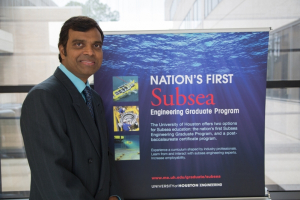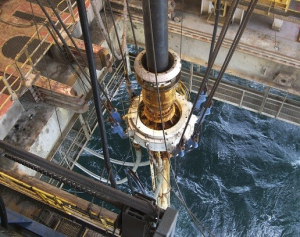When it comes to subsea engineering education, the University of Houston Cullen College of Engineering has a tradition of taking the lead.
UH started the country’s first academic program in the discipline in 2011 and offered the first subsea engineering master’s degree in 2012. In 2013, the Cullen College spearheaded the establishment of the Global Subsea University Alliance.
Now, seven years later, the subsea program is bigger, better and growing. Leading the charge is Phaneendra Kondapi, director of the program and a renowned pioneering instructor in the field. Here he shares his thoughts about subsea engineering, program direction and developing the next generation of subsea engineers.
What is subsea engineering?
PK: Subsea engineering in our context is petroleum engineering, but under the sea. It started out maybe 50 feet below the water around 60 years back, but now we’re talking about 10, 000 feet below the water and 20,000-25,000 feet below the seabed. That’s where we’re trying to bring the oil and gas up from and it’s very challenging. In fact, subsea engineering is a multidisciplinary field. It involves mechanical, chemical, petroleum, electrical and civil engineering disciplines integrated together.
We’re not talking about rocket science where you can see everything as it launches into the sky. You cannot see anything on the ocean floor, so the technology has to be very precise to avoid accidents. Engineers who create these technologies and work with subsea systems have to understand and appreciate the dynamic and unique challenges involved in the subsea environment.
Why did the UH Cullen College launch the subsea engineering program and how has it grown over the years?
PK: The offshore industry has been waiting a long time to have such a program in the U.S. There was a strong need to develop subsea skills in potential engineers and there was no such program until the UH Cullen College of Engineering made it a reality in spring 2011.
Engineers and executives throughout the industry helped formulate the curriculum and joined the program’s staff and advisory board. The University of Houston has become a pioneer in subsea engineering education and research because of the support from the industry. This program, developed by industry professionals and taught by industry experts, is designed to meet current and future industry needs and requirements.
It started with one course, “Flow Assurance,” in spring 2011, and has grown into 14 courses over the years. In fall 2017, we started offering a new course called “Guide to Engineering Data Science” and a graduate-level certificate in data analytics because, again, there is an industry need for them.
In the oil and gas industry, they look at a lot of data from each and every aspect. Industry professionals study data collected during seismic surveys to decide where to drill, from equipment readouts to ensure reliability, productivity and safety; and during the drilling process.
While the courses lean toward subsea engineering in terms of examples and problems used, the basics are the same, so any engineer can take the course. All engineers could benefit from knowing data analytics.
Being in Houston, we’re right in the heart of the Energy Capital, and now we’re also offering courses in Katy, which is right next to the Energy Corridor, so UH is the school best situated to offer a subsea engineering program. After all, we are Houston’s Energy University.
UH is proud to partner with the oil and gas industry to create a program that is relevant and serves the needs of the industry.
Who is the UH subsea engineering program geared toward?
PK: The program can benefit engineering students from any discipline who want to enter the field as well as working professionals who want to advance their knowledge and skills. We offer the Master’s degree in Subsea Engineering and two graduate certificate programs.
Students can take courses in Katy, at the UH main campus or online. We are a very flexible program.
What’s next for the subsea engineering program?
PK: Our program is very successful, but the industry has changed its direction in the last three years and we have to respond to that. Our curriculum needs to change to reflect the industry dynamics and fit the current and future needs of the subsea market. It’s our responsibility to stay ahead of the curve. The subsea engineering program prepares students to be industry-ready and I’m proud to say we’re the first such program to do so.
I want to reach a global audience in terms of students and working professionals with our offerings — someone sitting in Australia can earn their degree or certificate with our online classes. I also want to partner with corporations around the world and offer our students more knowledge and opportunities.
There are some exciting things we are planning to include in the program:
We are proposing three new dual master’s degrees — petroleum engineering and subsea engineering, mechanical engineering and subsea engineering, and electrical and subsea engineering.
We will also add two more graduate certificates to the program — a Flow Assurance Certificate and a SURF (Subsea Umbilical Risers and Flowlines) Certificate.
And we will offer a subsea engineering minor for undergraduates. Any undergraduate engineering student can opt for the subsea minor as long as the student qualifies for a minor.
All of these should be offered by fall 2018 or spring 2019, pending approval from the university.
I want to make the UH Subsea Engineering program the most relevant, comprehensive, dynamic and robust program in the world. And I want to make it available to every qualified prospective student across the globe.
Why should someone consider a master’s degree in subsea engineering from UH?
PK:
1. We are right in the center of the Energy Capital of the World, so our students have access to plenty of job and internship opportunities.
2. Salaries are relatively higher than other engineering disciplines.
3. Now that the oil and gas industry is coming back up and prices are stabilizing, companies are looking for people with knowledge and skills of subsea engineering. UH is offering that skill set. Our subsea engineering graduates are prepped to enter and succeed in the industry upon earning their degrees.
The subsea engineering minor will give students an edge when they are seeking jobs as fresh graduates. Companies will prefer them as candidates because it means those students already have some background knowledge and it’ll reduce on-the-job training time.
Finally, what do you think of new Trump’s plan on opening up offshore drilling and what will be the impact?
PK: It’s a very sensitive subject. For the industry, it’s always favorable news and from a political point of view, the U.S. wants to be energy dominant and energy independent – but is it worth putting entire coastal environment at jeopardy? Let’s see what happens on whether the proposal goes back to the shelves or not.
If offshore drilling is inevitable, five things have to be considered:
1. Initially identify only a few pockets of reservoir blocks that can be drilled with minimum risks.
2. Instead of scaling back, separate and stricter offshore drilling regulations need to be put in place.
3. Develop new technologies that minimize risk.
4. Implement the highest safety measures.
5. Bring all the offshore entities under one umbrella, a new national institute, for better governance.
And to meet the new demands, UH is always there to develop future subsea engineers.
Phaneendra Kondapi Bio:
With more than 20 years of experience managing engineering projects at energy industry giants FMC Technologies and KBR, Phaneendra "Phani" Kondapi brings a unique and invaluable skillset to his role as director of the subsea engineering program.
After serving as director of subsea engineering at Texas A&M University, Kondapi returned to UH in 2017 as the founding director of engineering programs in Katy. In this role, he will spearhead the expansion of UH Engineering programs that are in high demand in Houston's Energy Corridor, including petroleum, subsea, civil, electrical and environmental engineering.
Kondapi, who was instrumental in developing the program, also led efforts to standardize global subsea education through the University's Global Subsea Education Alliance. One of the pioneering instructors in the college's subsea engineering program, Kondapi began teaching the inaugural "Flow Assurance" course at UH in 2011.
He received the 2013 SPE Teaching Excellence Award from the Society of Petroleum Engineers (SPE) International, which recognizes petroleum engineering faculty who have demonstrated innovative teaching techniques and creative pedagogy methods in the classroom. Most recently he received both the SPE Gulf Coast Region 2017 Projects, Facilities and Construction Award and the Distinguished Achievement Award for petroleum engineering faculty.
Kondapi holds a B.S. and an M.S. in chemical engineering from Andhra University in India and a Ph.D. in chemical engineering from Tennessee Technological University.

